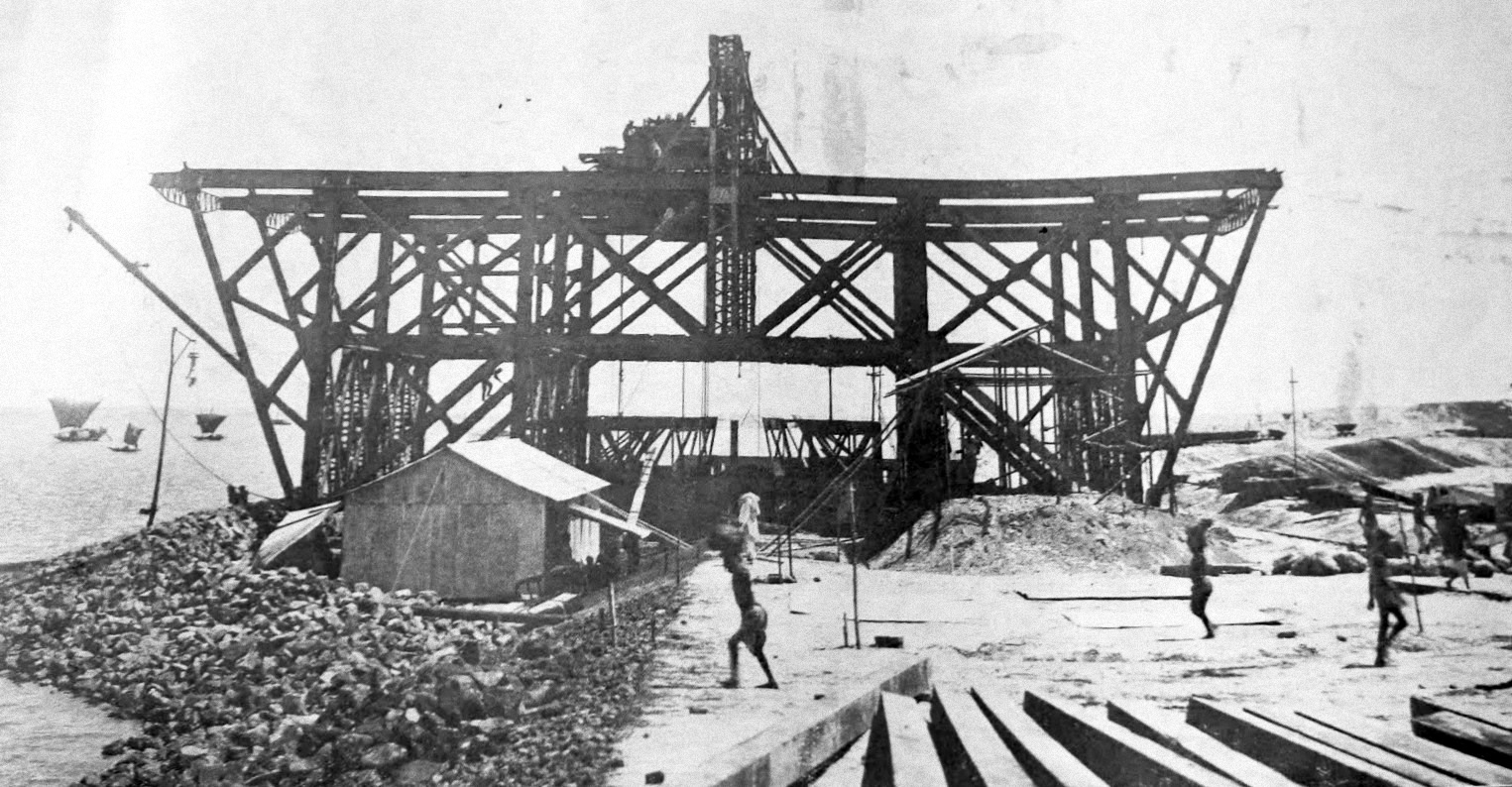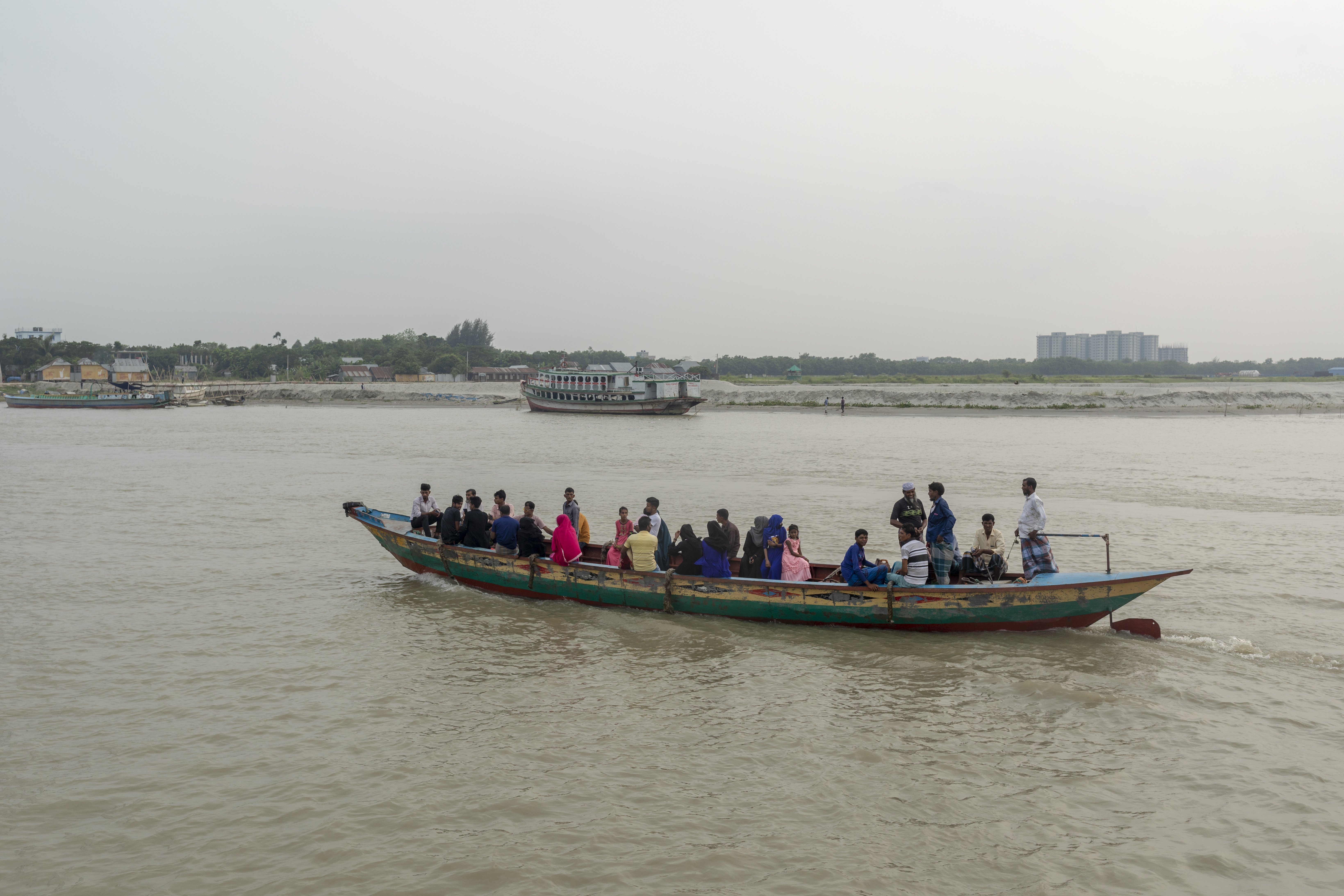|
Santahar Junction Railway Station
Santahar ( bn, সান্তাহার) is a railway junction in Adamdighi Upazila in Bogra District of Rajshahi Division in Bangladesh. History From 1878, the railway route from Kolkata, then called Calcutta, to Siliguri was in two laps. The first lap was a 185 km journey along the Eastern Bengal State Railway from Calcutta Station (later renamed Sealdah) to Damookdeah Ghat on the southern bank of the Padma River, then across the river in a ferry and the second lap of the journey. A metre gauge line of the North Bengal Railway linked Saraghat on the northern bank of the Padma to Siliguri. It was during this period that Santahar came up as a railway station. In 1899-1900 a metre gauge railway line was constructed between Santahar and Fulchhari, on the western bank of the Jamuna by Brahmaputra-Sultanpur Railway Company. The Kolkata-Siliguri main line was converted to broad gauge in stages. The Shakole-Santahar section was converted in 1910–1914, when Hardinge Brid ... [...More Info...] [...Related Items...] OR: [Wikipedia] [Google] [Baidu] |
Bangladesh Railway
Bangladesh Railway ( bn, বাংলাদেশ রেলওয়ে) is the state-owned rail transport agency of Bangladesh. It operates and maintains all railways in the country, and is overseen by the Directorate General of Bangladesh Railway. The Bangladesh Railway is governed by the Ministry of Railways and the Bangladesh Railway Authority. Its reporting mark is "BR". The Bangladesh Railway system has a total length of In 2009, Bangladesh Railway had 34,168 employees. In 2014, Bangladesh Railway carried 65 million passengers and 2.52 million tonnes of freight. The railway made 8,135 million passenger-kilometres and 677 million tonne-kilometres. History Rail transport in Bangladesh (the then British India) began on 15 November 1862, when 53.11 km of (broad gauge) line was opened between Darshana in Chuadanga District and Jogotee in Kushtia District. On 1 January 1871, extension of Darshana - Jogotee Railway line up to Goalanda by Eastern Bengal Railway. On 4 ... [...More Info...] [...Related Items...] OR: [Wikipedia] [Google] [Baidu] |
Railway Stations In Bogra District
Rail transport (also known as train transport) is a means of transport that transfers passengers and goods on wheeled vehicles running on rails, which are incorporated in tracks. In contrast to road transport, where the vehicles run on a prepared flat surface, rail vehicles (rolling stock) are directionally guided by the tracks on which they run. Tracks usually consist of steel rails, installed on sleepers (ties) set in ballast, on which the rolling stock, usually fitted with metal wheels, moves. Other variations are also possible, such as "slab track", in which the rails are fastened to a concrete foundation resting on a prepared subsurface. Rolling stock in a rail transport system generally encounters lower frictional resistance than rubber-tyred road vehicles, so passenger and freight cars (carriages and wagons) can be coupled into longer trains. The operation is carried out by a railway company, providing transport between train stations or freight customer faci ... [...More Info...] [...Related Items...] OR: [Wikipedia] [Google] [Baidu] |
Ahsanganj Railway Station
Ahsanganj railway station ( bn, আহসানগঞ্জ রেলওয়ে স্টেশন) is a railway station in Naogaon District, Rajshahi Division, Bangladesh. Jamindar Munshi Ahsanullah Mollah M.L.C established the station and then the station was named as the ''Atrai Ghat'' in the time of British rule but it was renamed after Munshi Ahsanullah Mollah (Founder) as Ahsanganj railway station. Then the station was built again by Mollah Abul Kalam Azad MP (Son of Munshi Ahsanullah Mollah). See also * Bangladesh Railway * Santahar railway station * Atrai Upazila Atrai ( bn, আত্রাই) is the southernmost upazila of Naogaon District, located in Bangladesh's Rajshahi Division. It is named after its principal watercourse, the Atrai River. Geography Atrai has 30570 households and total area 284.41&n ... References Railway stations in Naogaon District {{Bangladesh-railstation-stub ... [...More Info...] [...Related Items...] OR: [Wikipedia] [Google] [Baidu] |
Mukti Bahini
The Mukti Bahini ( bn, মুক্তিবাহিনী, translates as 'freedom fighters', or liberation army), also known as the Bangladesh Forces, was the guerrilla resistance movement consisting of the Bangladeshi military, paramilitary and civilians during the Bangladesh Liberation War, War of Liberation that transformed East Pakistan into Bangladesh in 1971. They were initially called the Mukti Fauj. On 7 March 1971 Sheikh Mujibur Rahman issued a call to the people of East Pakistan to prepare themselves for an all-out struggle. Later that evening resistance demonstrations began, and the military began a full-scale retaliation with Operation Searchlight, which continued through May 1971. A formal military leadership of the resistance was created in April 1971 under the Provisional Government of Bangladesh. The military council was headed by General M. A. G. Osmani''Unconventional Warfare in South Asia: Shadow Warriors and Counterinsurgency'', Gates and Roy, Routledge, 2 ... [...More Info...] [...Related Items...] OR: [Wikipedia] [Google] [Baidu] |
Stranded Pakistanis In Bangladesh
Stranded Pakistanis in Bangladesh ( ur, , , bn, উদ্বাস্তু পাকিস্তানি, udbāstu pākistāni) are Urdu-speaking Muslim migrants with homelands in present-day Bihar (then part of British India) who settled in East Pakistan (now Bangladesh) following the partition of India in 1947. This identification can encompass several groups of people. The first among them are Bihari Muslims. Although most of this population belonged to the Bihar Province of British India, there are many from other Indian states such as U.P. (United Provinces or later Uttar Pradesh). There are still others who had settled in what is now known as Bangladesh in the late 19th century. The second term of reference for this group coined by themselves after the creation of Bangladesh is "Stranded Pakistanis". In Urdu media in Pakistan and elsewhere this was translated as "Mehsooreen" or the "Besieged". Henceforth any of the above terms may be used to identify this group depe ... [...More Info...] [...Related Items...] OR: [Wikipedia] [Google] [Baidu] |
Bangladesh Liberation War
The Bangladesh Liberation War ( bn, মুক্তিযুদ্ধ, , also known as the Bangladesh War of Independence, or simply the Liberation War in Bangladesh) was a revolution and armed conflict sparked by the rise of the Bengali nationalist and self-determination movement in East Pakistan, which resulted in the independence of Bangladesh. The war began when the Pakistani military junta based in West Pakistan—under the orders of Yahya Khan—launched Operation Searchlight against the people of East Pakistan on the night of 25 March 1971, initiating the Bangladesh genocide. In response to the violence, members of the Mukti Bahini—a guerrilla resistance movement formed by Bengali military, paramilitary and civilians—launched a mass guerrilla war against the Pakistani military, liberating numerous towns and cities in the initial months of the conflict. At first, the Pakistan Army regained momentum during the monsoon, but Bengali guerrillas counterattacked ... [...More Info...] [...Related Items...] OR: [Wikipedia] [Google] [Baidu] |
Hardinge Bridge
Hardinge Bridge is a steel railway truss bridge over the Padma River located at Ishwardi, Pabna and Bheramara, and Kushtia in Bangladesh. It is named after Lord Hardinge, who was the Viceroy of India from 1910 to 1916. The bridge is long. Construction Construction of the through truss bridge began in 1910, though it was proposed at least 20 years earlier. It was constructed by Braithwaite and Kirk Company based on design of Sir Alexander Meadows Rendel. It was completed in 1912, and trains started moving on it in 1915. Brief history The construction of a railway bridge over the Padma was proposed in 1889 by the Eastern Bengal Railway for easier communication between Calcutta and the then Eastern Bengal and Assam. In 1902, Sir FJE Spring prepared a report on the bridge. A technical committee reported that a bridge could be constructed at Sara crossing the lower Ganges between the Paksey and Bheramara Upazila stations on the broad gauge railway from Khulna to Parbatipur Upazi ... [...More Info...] [...Related Items...] OR: [Wikipedia] [Google] [Baidu] |
Jamuna River (Bangladesh)
The Jamuna River ( bn, যমুনা ''Jomuna'') is one of the three main rivers of Bangladesh. It is the lower stream of the Brahmaputra River, which originates in Tibet as Yarlung Tsangpo, before flowing into India and then southwest into Bangladesh. The Jamuna flows south and joins the Padma River (''Pôdda''), near Goalundo Ghat, before meeting the Meghna River near Chandpur. It then flows into the Bay of Bengal as the Meghna River. The Brahmaputra-Jamuna is a classic example of a braided river and is highly susceptible to channel migration and avulsion. It is characterised by a network of interlacing channels with numerous sandbars enclosed between them. The sandbars, known in Bengali as ''chars'', do not occupy a permanent position. The river deposits them in one year, very often to be destroyed later, and redeposits them in the next rainy season. The process of bank and deposit erosion together with redeposition has been going on continuously, making it difficul ... [...More Info...] [...Related Items...] OR: [Wikipedia] [Google] [Baidu] |
Phulchhari Upazila
Phulchhari or Fulchhari ( bn, ফুলছড়ি) is an upazila of Gaibandha District in the Division of Rangpur, Bangladesh. Geography Phulchhari is located at . It has 40,489 households and total area 314.03 km2. Demographics According to the 2011 Bangladesh census, Phulchhari Upazila had 40,489 households and a population of 165,334. 46,512 (28.13%) were under 10 years of age. Phulchhari had a literacy rate (age 7 and over) of 31.25%, compared to the national average of 51.8%, and a sex ratio of 1003 females per 1000 males. 6,401 (3.87%) lived in urban areas. As of the 1991 Bangladesh census In 1991, the Bangladesh Bureau of Statistics, conducted a national census in Bangladesh. They recorded data from all of the districts and upazilas and main cities in Bangladesh including statistical data on population size, households, sex and ag ..., Phulchhari has a population of 128845. Males constitute 50.82% of the population, and females 49.18%. This Upazila's eighteen ... [...More Info...] [...Related Items...] OR: [Wikipedia] [Google] [Baidu] |
Padma River
The Padma ( bn, পদ্মা ''Pôdma'') is a major river in Bangladesh. It is the main distributary of the Ganges, flowing generally southeast for to its confluence with the Meghna River near the Bay of Bengal. The city of Rajshahi is situated on the banks of the river.Hossain ML, Mahmud J, Islam J, Khokon ZH and Islam S (eds.) (2005) Padma, Tatthyakosh Vol. 1 and 2, Dhaka, Bangladesh, p. 182 . Since 1966, over of land has been lost due to erosion of the Padma. History Etymology The Padma, Sanskrit for lotus flower, is a mentioned in Hindu mythology as a byname for the Goddess Lakshmi. The name ''Padma'' is given to the lower part of the course of the Ganges (Ganga) below the point of the off-take of the Bhagirathi River (India), another Ganges River distributary also known as the Hooghly River. Padma had, most probably, flowed through a number of channels at different times. Some authors contend that each distributary of the Ganges in its deltaic part is a remnant ... [...More Info...] [...Related Items...] OR: [Wikipedia] [Google] [Baidu] |
Junction Station
''Junction station'' usually refers to a railway station situated on or close to a junction where lines to several destinations diverge. The usual minimum is three incoming lines. At a station with platforms running from left to right, the minimum to qualify as a junction station would usually be one line on the left and two on the right (or vice versa). This is not to be confused with a station where there is one through line, but single track on one side while double track on the other. In this case, all trains passing through the station can reach only one destination as their next station. Commonly, junction stations have multiple platform faces to enable trains for multiple destinations to stand at the station at the same time, but this is not necessary. There are many stations with the word 'junction' in their title, such as those below: In Australia * Bondi Junction railway station *Eagle Junction railway station In Canada * Hervey-Jonction railway station * Sudbury Ju ... [...More Info...] [...Related Items...] OR: [Wikipedia] [Google] [Baidu] |




